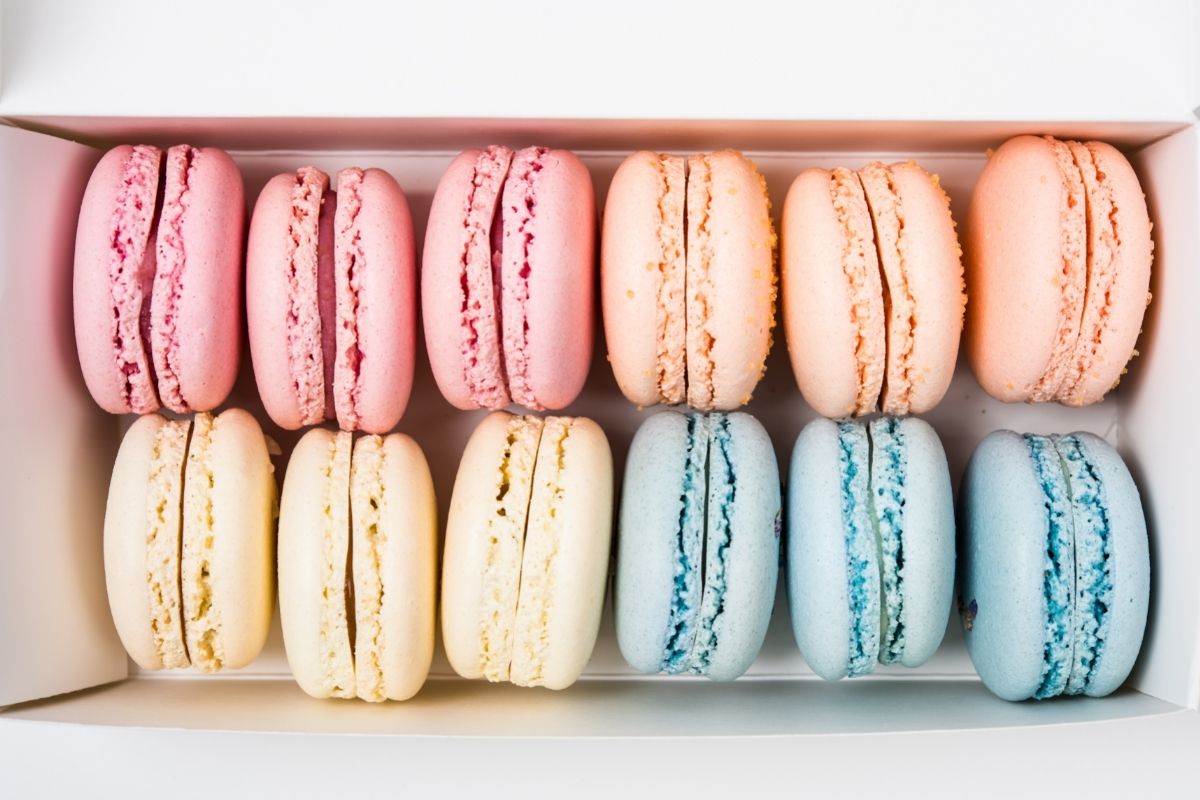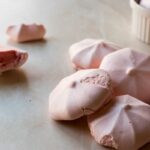If you’re throwing a fancy soirée, French macarons are the perfect sweet treat to offer your swanky guests, and due to their lovely pastel colorings, they can act as both party snack and party decoration – that’s some pretty impressive food!
However, macarons are notoriously tricky to make, and as we’re not all French master chefs you likely don’t have much experience baking or eating them, so figuring out if you’ve done a good job once they’re finished can be perplexing.
For instance, what is the ideal texture of a macaron. They look to be quite hard, or at the very least crisp, so is a chewy macaron a blunder, or is that how they’re supposed to be? Let’s find out!
What Are French Macarons?
The French macaron is a delightful and ingenious dessert composed of ganache, buttercream, or jam filling sandwiched between two delicate meringue cookies – they’re basically the Oreos of the fancy pants world.
The meringue macaron shells are typically made using almond flour, food coloring, icing sugar, granulated sugar and egg whites, and the flavor of the macaron fillings can range from a traditional: raspberry and chocolate, to the downright bizarre: matcha or foie gras.
Due to this rather elegant and fiddly composition, baking french macarons can be quite the task. Even if you’re following a French macaron recipe to the word, a lot can go wrong, including split fillings, cracked macarons, flat macarons, and so on.
But, if you’re up for a baking challenge, then, by all means, press on!
What Should The Texture Of French Macarons Be Like?
If you’ve completed your first set of French macarons, and they’ve come out with a chewy texture, it could be a good or a bad thing – It all depends on just how chewy the texture is.
The perfect French macarons should have a melt-in-the-mouth texture with a slight chewiness, similar to your typical meringue.
The outer layer of the macaron shells should break with a crispy crunch, and the inner meringue combined with the filling should make for a soft and chewy center.
Furthermore, after that initial crunch of the outer macaron shells, it should have a superbly smooth mouth-feel.
Why Do My Macarons Have A Coarse Texture?
The outer layer of the macaron shells should also be silky smooth, but due to a couple of common mistakes, they can come out with a rather rough texture.
The number one cause of a meringue shell with a sandpaper like finish is the use of almond meal, but don’t feel too bad if this has happened to you, as it may not be your fault.
Many a French macaron recipe calls for the use of almond meal, as, traditionally, this was the correct ingredient, but these days, you should really only use almond flour.
Now I know what you’re thinking… Almond meal, almond flour – what’s the difference? Well, despite both being the product of ground almonds, they have a distinctly different feel, and it’s these differences that present themselves in your finished macarons.
Almond flour is much finer, amounting to a smoother, lighter, more cake-like texture. Almond meal, on the other hand, is coarser, and commonly used to make less cake-like bakes such as bread. Of course, it’s a great substitute if you don’t own almond flour, but your macarons will suffer.
It could be that even though you used almond flour, your macaron shells are still coarse, which is usually the case if you failed to sieve the almond flour mixture effectively.
Pro Tip – Use blanched almonds if making your own almond flour, as this gives your macarons a very clean presentation.
Why Are My French Macarons Hard?
There are three reasons for a tough French macaron. One is that you overworked your macaron batter, a common error that almost all beginners make.
When mixing your meringue for the macaron shells, you’re looking for stiff peaks.
No stiff peaks mean it’s under-worked. Likewise, going too far the other way will leave you with overly thick batter and rigid rather than stiff peaks.
If you’ve taken your batter too far, you can add cream or egg white to thin it out. Do not beat the egg white beforehand though.
Remember, this is going to be piped batter, so it can’t be too thick, but overly thin batter is a problem in of itself. It’s best to make more than you need so if you make a mistake, you can amend the remaining batter and try again
The third and final cause of a tough French macaron is overbaking. Your oven temperature should be between 280 and 290 degrees Fahrenheit, and you should bake macarons for 14 to 16 minutes only.
If you think your French macaron shells are a tad hard, don’t act too hastily, as once they’re filled and maturing in the fridge, they’ll soften a bit.
Why Don’t My Macarons Have Feet?
Feet, in this context, refer to the signature ruffled edge of the macaron shell, the telltale sign of beautiful macarons. If yours have come out rather footless, it could be that your macaron batter was too wet, contained less sugar than necessary, was overworked, or not given enough resting time at room temp.
A fix for this would be to use aged egg whites to dry things up. You could also avoid liquid flavorings and colorings – a gel food coloring will be better.
If you add gel food coloring to your mix, it will provide a necessary pop of color without saturating the batter.
Why Are My Macarons Brown?
Simple answer here… your oven temperature was too high, or, if it’s just one or two macarons, you’ve got a hot spot issue.
Why Are My Macarons Chewy To The Extreme?

An overly chewy macaron comes down to poorly mixed and baked meringue batter. If it’s also quite grainy, it might be worth switching out the granulated sugar for ultrafine sugar in the future.
Why Are My Macarons Uneven?
A wonky macaron can be the product of shabby piping bag use or an uneven baking sheet, sheet pan, or silicone baking mats. For the piping issue, I’d recommend using a macaron template, and for an uneven cooking surface, you’ll need a replacement.
Why Are My Macarons Hollow?
To avoid cavities in your macarons, simply whip egg whites for longer. 5 to 7 minutes is perfect, and don’t hesitate to use a stand mixer or the mixing facilities of a food processor. A stand mixer may get the job done a few minutes early, so they’re good in a time-sensitive situation.
What Meringue Method Should I Use For Macarons?
The French method is generally seen as the most effective for macarons, but there are plenty of macaron recipes that utilize the Italian meringue method as well.
Although the French method creates that wonderful tension between firm and crumbly, the Italian method might be preferable for beginners due to the stability of Italian meringue.
My advice is to try both the French method and the Italian method.
What Is The Most Basic Recipe For Macarons?
If you’re looking to keep things simple to start with, you can make quality macarons with the following list of four ingredients:
- Fresh egg whites
- Granulated sugar
- Almond flour
- Powdered sugar
Final Thoughts
Making macarons can be tough, but I hope my macaron tips have made your first attempts play out a little smoother. If you’re having trouble with one recipe, simply try your hand at a different recipe. You’ll find one that gels with you in no time!





